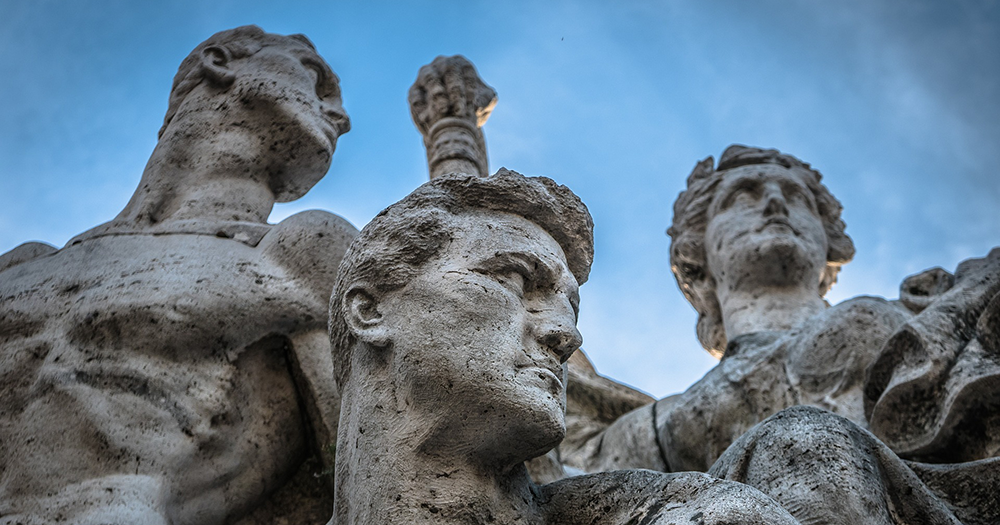Orgies and debauchery, ancient Rome and gay sex together are often connected to hedonism. But when looking closer at Rome’s practices regarding LGBTQ+ relationships, it becomes obvious that even in the historic society, not everything was sexual freedom and parties.
From Emperor Nero, who had several marriages to men and women alike, to Emperor Elagabus, who is sometimes called the first transgender empress of Rome, and even when reading between the lines of insulting poems calling out Ceaser for sleeping with another man, very well-defined rules for same-sex relationships can be found throughout the empire’s history.
Fun Fact: Caesar was given the title "Every woman's man and every man's woman" as he was very attractive and had several affairs with many women but was topped by Niomedes during gay sex. And, since everything in ancient Rome was abt power dynamics, he never lived it down.
— Abigail✡️? (@CelestRaspberry) July 18, 2021
Relationships in ancient Rome were determined more through class than anything else. Within the militant and patriarchal worldview of the ancient Romans, there was no word describing homosexuality (the same applies to heterosexuality or bisexuality) as we know it today. The terminology was dependent on the roles the participants would take during sex. Only the part regarded as active, meaning the penetrative part, was seen as masculine, making it the only socially acceptable way to participate in same-sex relationships for freeborn men.
The other important thing when wanting to have gay sex in a socially acceptable way was that the man taking the ‘passive’ part had to be socially inferior to the other one. In ancient Rome, a free citizen was not allowed to sleep with another free citizen, or with another’s wife or children, for that matter. He could, however, take, for example, prostitutes, actors or slaves to bed. This was acceptable even when he was married. Also common was the practice of taking a boy or young man between the age of 12 and 20 as a lover.
One of the most famous examples of this might be Emperor Hadrian’s relationship with a young man called Antinous. They are said to have been in a relationship until Antinous tragically drowned in the Nile at the age of 20. Hadrian was so affected by this that he had his lover deified and worshipped in a dedicated cult across the empire.
Happy Birthday Emperor Hadrian; you went to Greece, took too many psychedelics, fell head over heels for a twink, got ‘spiritual’, took a reckless river cruise on a party boat and fucked up your life. Truly you were a gay before your time pic.twitter.com/CiyNqfC9Xi
— Bad Gays (@badgayspod) January 24, 2022
What we know today has mostly been preserved through text that was passed on. Love between men is a frequent theme in Roman literature. Recorded in plays and poems through all existing genres, the desire of Roman men has survived throughout the times. Scholars estimate that in poems that are preserved to this day, love for boys is thematised as often as love for women.
Not mentioned in texts from the time period, however, is sex between women, possibly because the Romans only considered sex involving penetration as sex. Even so, historians have found love spells written by women to woo other women, suggesting that not only were women in ancient Rome having gay sex but were also involved romantically. Historians additionally agree that men were not only sexually but also romantically involved, but these relationships were kept secret because they were not seen as socially acceptable.
© 2023 GCN (Gay Community News). All rights reserved.
Support GCN
GCN is a free, vital resource for Ireland’s LGBTQ+ community since 1988.
GCN is a trading name of National LGBT Federation CLG, a registered charity - Charity Number: 20034580.
GCN relies on the generous support of the community and allies to sustain the crucial work that we do. Producing GCN is costly, and, in an industry which has been hugely impacted by rising costs, we need your support to help sustain and grow this vital resource.
Supporting GCN for as little as €1.99 per month will help us continue our work as Ireland’s free, independent LGBTQ+ media.

comments. Please sign in to comment.